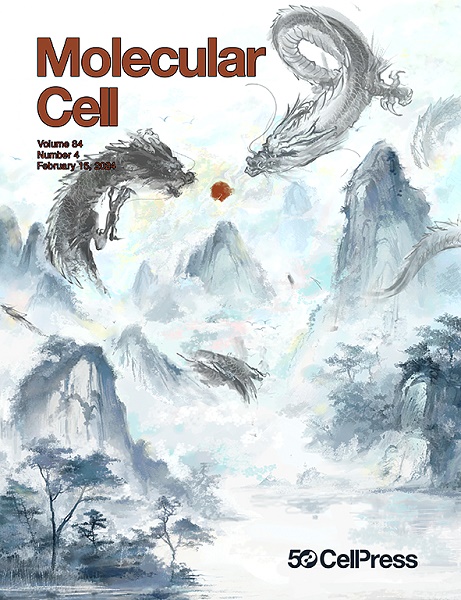H3K27去甲基化的结构机制及与异染色质标记的串扰
IF 14.5
1区 生物学
Q1 BIOCHEMISTRY & MOLECULAR BIOLOGY
引用次数: 0
摘要
组蛋白H3赖氨酸27三甲基化(H3K27me3)是一种抑制性组蛋白修饰,是兼性异染色质的标志。H3K27me3由多梳抑制复合体2 (PRC2)安装,并由KDM6家族Jumonji C (JmjC)结构域去甲基化酶去除。结构研究已经阐明了PRC2在核小体上的功能及其通过局部组蛋白修饰特征的调控。然而,控制H3K27去甲基化以重新激活沉默的染色质的分子机制仍然知之甚少。在这里,我们报道了与核小体结合的小鼠KDM6B的冷冻电镜(cryo-EM)结构。我们的结构显示了KDM6B如何将包裹的核小体DNA与核外体DNA连接在一起,定位其催化JmjC结构域,用于H3K27去甲基化。KDM6B在致密染色质环境中诱导与功能一致的重叠连接体DNA构象。我们进一步发现,在异染色质中富集的连接体组蛋白和H2AK119ub1都能拮抗KDM6B功能,这表明在异染色质激活过程中,连接体组蛋白移除和H2A去泛素化先于H3K27去甲基化。本文章由计算机程序翻译,如有差异,请以英文原文为准。

Structural mechanism of H3K27 demethylation and crosstalk with heterochromatin markers
Histone H3 lysine 27 trimethylation (H3K27me3) is a repressive histone modification that is a hallmark of facultative heterochromatin. H3K27me3 is installed by the polycomb repressive complex 2 (PRC2) and removed by KDM6 family Jumonji C (JmjC) domain demethylases. Structural studies have elucidated how PRC2 functions on nucleosomes and its regulation by local histone modification signatures. However, the molecular mechanisms governing H3K27 demethylation to reactivate silenced chromatin remain poorly understood. Here, we report the cryoelectron microscopy (cryo-EM) structure of mouse KDM6B bound to the nucleosome. Our structure shows how KDM6B engages wrapped nucleosomal DNA together with both extranucleosomal DNA linkers to position its catalytic JmjC domain for H3K27 demethylation. KDM6B induces an overlapped linker DNA conformation consistent with function in a compact chromatin environment. We further show that linker histones and H2AK119ub1, both enriched in heterochromatin, antagonize KDM6B function, suggesting that linker histone eviction and H2A deubiquitylation precede H3K27 demethylation during heterochromatin activation.
求助全文
通过发布文献求助,成功后即可免费获取论文全文。
去求助
来源期刊

Molecular Cell
生物-生化与分子生物学
CiteScore
26.00
自引率
3.80%
发文量
389
审稿时长
1 months
期刊介绍:
Molecular Cell is a companion to Cell, the leading journal of biology and the highest-impact journal in the world. Launched in December 1997 and published monthly. Molecular Cell is dedicated to publishing cutting-edge research in molecular biology, focusing on fundamental cellular processes. The journal encompasses a wide range of topics, including DNA replication, recombination, and repair; Chromatin biology and genome organization; Transcription; RNA processing and decay; Non-coding RNA function; Translation; Protein folding, modification, and quality control; Signal transduction pathways; Cell cycle and checkpoints; Cell death; Autophagy; Metabolism.
 求助内容:
求助内容: 应助结果提醒方式:
应助结果提醒方式:


